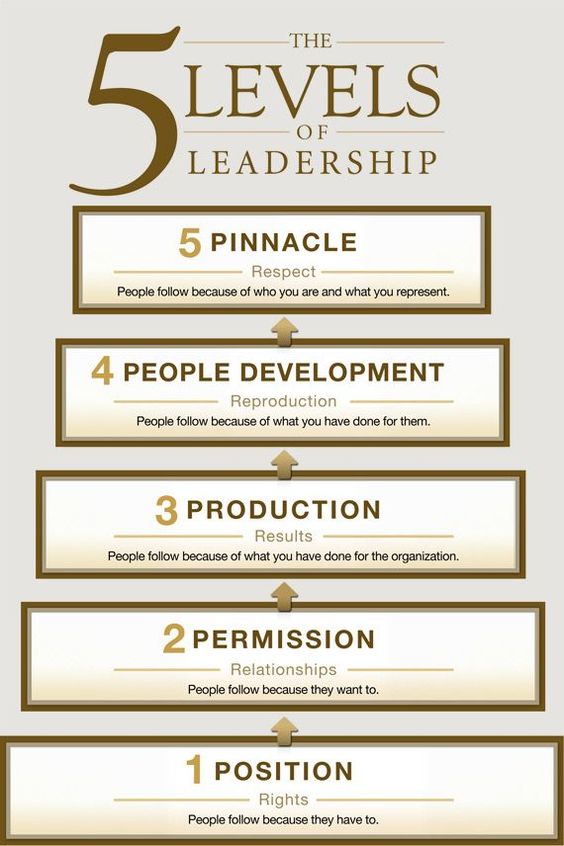Leaders play a crucial role in all possible walks of life, whether it is the boardroom, the courtroom, classroom, or even the battlefield. They are vital to the basic functioning of an organization and help bind the workforce to the values of the organizations and guide them along the path to success. Leadership is like a ladder. It has ascending levels that take time and practice to master, and moving up means to be able to balance between personal growth, the growth of the organization as a whole, and the success of subordinates.
How does one, therefore, reach the pinnacle of this ladder? Developing the Leader Within You (1993) by John C Maxwell, shows the way to master the levels of leadership, imbibe the necessary qualities and traits needed to succeed as a leader, and how to take concrete steps to steadily, but surely reach the peak.

The Five Levels Of Leadership
To begin understanding leadership, it is essential to understand that it is a crucial quality that powerful people possess. Leadership is simply, the ability of a person to influence others or a group of people. That said, anyone who has the ability to make others follow them could be termed as a leader. JFK, Churchill, and even Hitler can be called a leader.
Leadership has 5 levels of hierarchy. Every leader has to master each level and move up the ladder to the next one. The five levels of hierarchy are –
- Position – This is the first level of leadership. Those who are leaders at this level are leaders merely due to their titles in the organization.
- Permission – Permission is all about being attuned to the needs of followers. It entails building and maintaining relationships with followers. At this level, if the leader neglects the needs of his followers, the followers will lose interest in the leader.
- Production – At the production level, leadership becomes the product of the success of the followers (team). At this level, the leader works hard to ensure that the team works towards producing formidable results while being tuned to their needs at the same time.
- People Development – The fourth level of people development entails focusing on mentorship. In this level, both the leader and the follower have a sense of loyalty; the follower towards following the guided path, and the leader towards guiding the follower towards success by helping them grow and acquire new skills.
- Personhood – A leader who has attained personhood, has spent his entire life working for the success of their team members. They reach this level only because they have constantly strived to put the successes of their team members, organization, peers, and colleagues before their own. This final level requires constant perseverance. It is the level where a leader naturally commands respect, loyalty, and inspiration for others to follow.
Now that we know the five levels of leadership, let us look into how we can master each of them, and reach the top of the ladder.

Setting Priorities
Setting priorities seems like a simple task. However, at the leadership level, it is much more than just known which task takes precedence and what to focus on. We all come across tasks that are important, tasks that are urgent, tasks that are neither important nor urgent, and tasks that are both, important and urgent.
Apart from tasks, prioritizing also extends to other things such as time, energy, money, staff allocation, etc. in order to be able to successfully prioritize, one can use the 20/80 rule. The rule states that –
- 80% of the resources such as money and time should be allocated to the top 20% organizational priorities,
- The top 20% of the most productive staff accounts for 80% of the organizational successes, therefore, 80% of the leader’s time should be dedicated to them.
- Barring the top 20% organizational priorities, the remaining 80% should be delegated or outsourced.
- And the top 20% of the organization should train new recruits.
Put simply, a leader should be able to prioritize the most important tasks and invest time, money, and energy in the top employees to be productive and successful.
Letting Integrity Be Your Compass
What is integrity? Integrity is having a set of values that a leader adheres to, without wavering. This set of rules become the compass that guides the leader forwards. Integrity involves being consistent and true with words as well as actions.
People get inspired to follow a leader’s actions. Therefore, if the leader leads by example, and follows his words with actions, he will be trusted and respected. Consistency in showing integrity will reinforce credibility and thereby help garner trust. Integrity makes the foundation of a long-lasting reputation that will endure.
Creating Positive Change
Adapting to change is one of the most important characteristics of a leader. With the work environment being fast-paced and dynamic, a leader has to be prepared to brace the changes in time. Inability to adapt and change can adversely affect the organization and most likely, the leader and/or his organization could succumb to competition.
Apart from being able to adapt, a leader should be able to envisage the psychological changes that his employees will undergo as well as the challenges that they will face. Any form of change leads to insecurity and stress in the organization. The onus, therefore, lies on the leader to make sure that his team is aware in advance, of the changes that they should expect and the objectives those changes aim at achieving. This will lead to creating positive change in the organization.
Self-Discipline
Self-discipline is an extremely crucial characteristic of good leaders. Without self-discipline, a leader cannot, and should not expect others to follow him or her.
Self-discipline involves focus and practice on a daily basis. That is why it takes a lot of time to develop self-discipline. Additionally, without self-discipline and hard work, the growth of the leader, and thus, in turn, the growth of the organization gets stunted.
Leaders can use the following to inculcate a habit of self-discipline.
- Start by making a list of five areas where you want to become more disciplined.
- Identify a mentor, peer, or colleague who is already disciplined in a particular area and ask them to monitor your progress.
- Take fifteen minutes every morning to chart out your plan as to how you are going to work on the areas, and then revaluate for five minutes in the afternoon and five minutes in the evening to reflect on the daily progress.
- Ideally, repetition of the same task help inculcating a habit. Cross the area of the list and move on to the next area.
Having A Vision
A leader should have a clear vision of their end goal in their mind. They need to envision where they plan to take the organization in terms of growth and success. Additionally, they should be able to have an idea of how they plan to persuade their team to reach the goal. The vision of the leader should fuel the daily working of the organization, the team, and the leader himself.
Without a vision, a leader cannot lead others towards a goal, because, without a goal, a leader will not believe deeply enough to strive hard, to persevere, to add team spirit, or the drive-in his team to perform.
However, not all leaders have a vision in place or a drive to leadership by a vision. Some need to build one. In such cases, leaders need to constantly keep questioning their dreams. They need to ask themselves, what keeps them going on day after day. Most importantly, they need to know if they can walk the talk and put their dreams into action.
Final Message
People follow leaders who have integrity. Moreover, they want to follow a leader with substance, self-discipline, and one who has the experience of driving his vision. They follow a leader who is open to change and is able to shift gears in the face of change.
Whatever level of leadership one stands at, they can move to the next level of leadership by keeping in mind the aforementioned practices.
